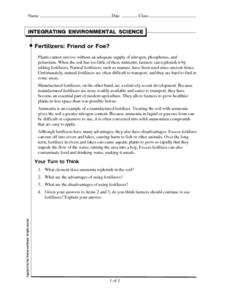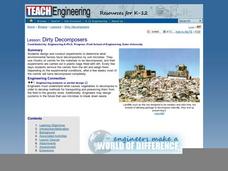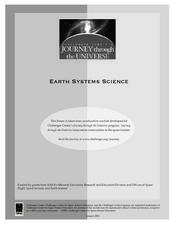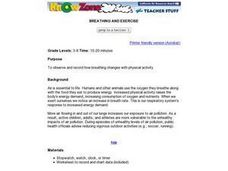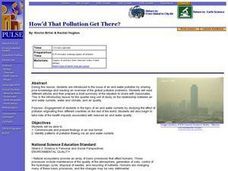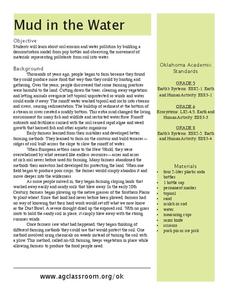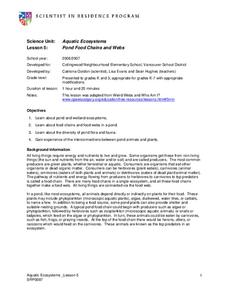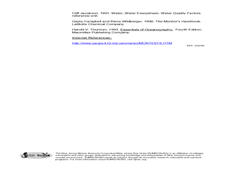Curated OER
Lub Dub
Students name the vessels and parts of the heart. They trace the path of blood through the heart. Students examine the function of the circulatory system. They recognize the differences between a hear when the body is at rest opposed to...
Curated OER
Mini-Ponds
In this mini pond worksheet, students create a mini-pond ecosystem with soil, water, and plant life. Students let their ecosystem sit for a day and they observe a sample the next day. Students identify all the pond water microorganisms...
Curated OER
River System
Fifth graders explore the parts of a river system and understand the importance of each part. In this river system lesson, 5th graders diagram a river system and write a paragraph explaining its parts.
Curated OER
Fertilizers: Friend or Foe?
In this fertilizer worksheet, students read about natural and manufactured fertilizers. They answer four critical thinking questions about fertilizers and their use.
Curated OER
What is an Angiosperm?
In this plant worksheet, students study a diagram of a magnified root cross-section. Students use this diagram to complete 2 true or false questions.
Curated OER
Hypoxia and the Dead Zone in the Gulf of Mexico
Students investigate the causes of hypoxia, the characteristics of a watershed, and how the actions and management practices of people can both negatively and positively affect aquatic ecosystems.
Curated OER
Soil Microbiology- Nitrogen cycle
Students take a virtual trip to a Catfish Aquaculture Pond and analyze soil bacteria to determine how many nitrogen cycle bacteria are present. They graph the number of colonies present and use data to determine ammonium levels in the soil.
Curated OER
Tree Friends
Students are introduced to tree structure and use. They identify their special tree using all senses except sight. Students identify six different internal parts within a cross section of tree trunk (bark, phloem, xylem, cambium,...
Curated OER
Dirty Decomposers
Seventh graders design and conduct experiments to determine what environmental factors favor decomposition by soil microbes. They use chunks of carrot for the materials to be decomposed, and their experiments are carried out in plastic...
Curated OER
Earth Systems Science
Students perform experiments designed to grow plants and bacteria in a controlled environment. In this ecosystems instructional activity students investigate varying conditions for growing plants and bacteria.
Curated OER
Fun Photosynthesis
Second graders, using large colored poster board, explore photosynthesis and its effect on the food chain and survival of organisms.
Curated OER
Breathing Rates and Exercise
Students work in groups to predict which condition produces more breaths per minute. Groups record their breathing rates during rest periods and periods of activity. They graph their results and make comparisons to their predictions.
Curated OER
Environment: How'd That Pollution Get There?
Students examine how global wind and water patterns aid in the spread of worldwide pollution. In groups, they read articles about the domino effect of pollution and create posters displaying its journey. On blank world maps, students...
Curated OER
Exploring Ecology
Students explore the basics of ecology. They discuss ecological succession, the water cycle and human impacts on the environment. Students explore the owls, succession, the human impact on the environment and complete the "Incredible...
Curated OER
Biomes
In this biomes instructional activity, students review the characteristics of aquatic biomes and terrestrial biomes. This instructional activity has 12 fill in the blank, 6 multiple choice, and 4 short answer questions.
Curated OER
Breathing and Exercise
Students observe and record how breathing changes with physical activities. In this physical activity instructional activity students form groups and complete their activity and worksheets.
Curated OER
Knowledge Quiz
For this oceans quiz worksheet, students complete a 10 question multiple choice quiz covering a variety of concepts related to the ocean.
Curated OER
Mud in the Water
Sixth graders investigate erosion. For this erosion lesson, 6th graders explore how farming changes the environment. Students construct an erosion model and research ways to protect the soil from excess mud generated by farming.
Curated OER
Edible Plants
Students determine what part of a plant they are eating when they eat different fruits and vegetables.
Curated OER
So, What's it Doing Today?
Learners describe short-term variations in oceanographic parameters in the Gulf Stream. In this ocean habitats lesson plan students use satellite imagery to obtain information in the Gulf Stream.
Curated OER
Aquatic Ecosystems
Students study ponds and wetland ecosystems and examine the food chains and webs in them. In this aquatic ecosystems lesson students answer questions about the diversity of the flora and fauna in a pond.
Curated OER
Water Quality Monitoring
Students comprehend the four parameters of water quality. They perform tests for salinity, dissolved oxygen, pH and clarity or turbidity. Students comprehend why scientists and environmental managers monitor water uality and aquatic...
Curated OER
What is an Estuary?
Pupils define the terms estuary and watershed. They conduct an experiment to determine the density differences between fresh and saltwater. They examine the salinity distribution of the Peconic Bay Estuary.
Curated OER
One-Way Valves
Students explore how the heart pumps blood through its valves. They observe fluid moving through a one-way valve and build a model of a valve. in addition, they explore biotechnology design.



